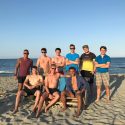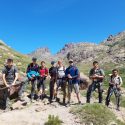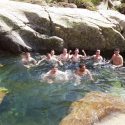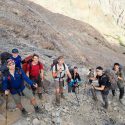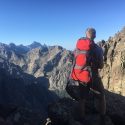Overview
This report covers all activities and events that were undertaken by those participating in EX DRAGON STOIC SCHOLAR (DSS). This was a Summer Mountaineering expedition run in accordance with the initial JSATF(A). It was conducted on the Parc Naturel Regional de la Corse, Corsica, a 180km route through the Corsican mountain range, of which DSS completed 100km. This was the first time this expedition has been run by EMUOTC and saw 8xEMUOTC OCdt’s with the SMF qualification undertake the expedition under the supervision of 1xSML within the dates of the 6th – 21st of August 19.
Aims
The aim of the expedition was to develop individual leadership and navigation skills during a 10-day trek of the GR20, and to gain experience in a remote challenging environment in order to further mountaineering qualifications for the unit.
This physically demanding exercise was in place to develop individuals hill fitness and to encourage others to take on the task of organizing further expeditions for EMUOTC. A harsh hot climate combined with an extreme physical challenge was chosen to develop mental resilience and instill a strong sense of camaraderie.
On looking back at the aims of the expedition I am led to believe all were met and the expedition exceeded all expectations. I would not amend the expedition aims.
Expedition
06/08/2019: After conducting pre-ex prep on the 5th August we set off and left Beeston ARC at 0600. It was a good start reaching Folkestone Euro Tunnel terminal earlier than expected allowing us to catch the 1120 train rather than the 1150. Departing Calais at around 1200 we left for Lyon and our overnight accommodation. It was expected to take 7 and a half hours. However, this turned into 10 and a half mostly due to the fact the minibus was speed restricted to below the speed limit, 65mph. (Something that was not taken into consideration). We reached Lyon at approximately 2200, the triple room accommodation was basic but was suitable for an overnight travel stay. Supplying hot water, 1x single bed and 1x double bed.
07/08/2019: Due to a delay in breakfast in the morning we did not set off until 0830, once again we were caught out by the speed limiter on the minibus when we realized time was going to be tight in catching the Nice ferry. After being bogged down in traffic due to a civilian RTC we had to accept the fact that we were not going to make our ferry timing. As such I phoned the Corsican ferry company to transfer the ticket times for the next morning.
We came up with a quick contingency which was to drive down to Savona, Italy and stay in a local campsite until the ferry in the morning. Once in Savona we stayed overnight at a campsite named “Camping Charley”. Although more expensive than the campsite we had planned to stay at in Corsica, it was highly suitable containing, washing facilities and electricity.
– Camping Charley, Savona, Via Nizza, 96R, 17100 Savona SV, Italy
08/08/2019: Departing Savona at 0830 via ferry we reached Corsica at 1515. We arrived at Camping Calenzana at 1730, which was very reasonable. Offering cooking and washing facilities. A supermarket is located just a 5 minute drive away which contains all the necessities.
09/08/2019: This was the first day of walking for the expedition and we set off at 0800. It was a shock to the system, quite brutal. It was consistently rough vertical ascent. Be sure that you check regularly for the red/white markers in order to not stray from the correct route. One of the main issues this day was that we were still ascending during the midday heat. I would recommend that you make a much earlier start to avoid the burning heat, 0700. After the first day walking it was also noted that the 3 litres carried by all is not sufficient and 4 litres should be minimum. The first day saw us cover 12km in just under 7hrs, with a total ascent of 1550m and descent of 235m.
Refuge d’Ortu di u Piobbu is a well-stocked refuge offering basic provisions, washing and cooking facilities as well as a fresh water source. At point to note is that there is a large crag at the end of the campsite, making a perfect viewing point for the evening sunset.
10/08/2019: At a steady pace it is a reasonable ascent upwards. This was made especially easier since we left at 0700. Once the ascent is completed you are presented with a spectacular view of the Corsican mountains in all its glory, conveying the vigor’s that are to come. The descent down was extremely tough on the feet. Not aided by the fact that the descent is reached during the midday sun offering very little shade. On this day we climbed 750m with 1050m of descent in approximately 6hrs 30 minutes.
Refuge de Carozzu offered the same facilities as Refuge Piobbu, however it is more compact and camping spots offer far more shade due to its location in a wooded area.
11/08/2019: Do not underestimate this day. Although only 6km it will take around 5hrs 30 minutes. The walk out of Carozzu is easy enough descending into a gorge. After crossing a suspension bridge, it marks the beginning of your day’s ascent. Encountering some of the steepest sections of the route yet you will be scrambling at points. Once again, the descent seems to bring the worst of it. Upon reaching the Bocca A I Stagni gap you will have full view of the Ski Resort Ascu Stagnu. Despite being easily visible it does not seem to move any closer, this descent will take around 1hr 30 minutes.
On this day we completed 6km, with 860m of ascent and 710m of descent. Ascu Stagnu offered far more provisions to that of the previous refuges due to its road access. As such provisions here are far cheaper and plentiful.
12/08/2019: Trekking from Ascu Stagnu to Auberge U Vallone. This was one of the longest and most demanding days of the expedition due to the extra optional ascent of the tallest peak on Corsica Mont Cinto. Once again, the trek from refuge Stagnu is relatively easy going and the ascent is marked by a crossing of another footbridge. This ascent is one of the most demanding of the GR20, climbing 1250m over 3km. Leaving at an early time you can make the top of the ascent before the sun hits the marked route.
For the ascent of Monte Cinto, it is recommended to drop all bags at to carry on with just a water bottle the 45 minute ascent is mostly scrambling and will require you to be on all fours at some points. For this part there is little shade, but the mountain breeze keeps you relatively cool.
Depending on the fitness of the group you will have the opportunity to stay at Refuge de Tighjettu or to trek onto Auberge U Vallone. I would recommend the trek onto Auberge U Vallone because of the far better camping spaces available, in addition to the beautiful rock pools which offers a refreshing moral booster. The only disadvantage is that Auberge U Vallone does not offer any cooking facilities, unlike all the other previous refuges.
Including the ascent of Monte Cinto and breaks this day of trekking took approximately 10 hours. I would also recommend setting a departure time of 0600 in order to complete the steep ascent in maximum shade.
13/08/2019: The first four days of the GR20 are by far the most challenging. But that is now all in the past. From now on the days become slightly easier under foot and the ascents not as sharp. Trekking from Auberge U Vallone an easy start through a forested valley gives way to a very steep and rocky climb which again at points requires some scrambling. This section is far steeper than the guidebook lays on, although it is easier than the previous days, it still should not be underestimated and presents quite the challenge.
Once reaching the crest of the climb the walk is very easy going and you can make extremely quick time. We managed to complete this day in 5 hours, despite the guidebook saying 6. We covered 15km, ascended 850m and descended 870m. Hotel Castel di Vergio is a great campsite being near enough situated on soft, flat ground, with washing, cooking facilities and plentiful provisions.
14/08/2019: Possibly the easiest stage of the route so far. You will have a relatively easy and pleasant walk over the mountains passing by the Lac du Ninu. DO NOT swim in the lake, a civilian hiker drowned minutes before we arrived because of its depth and housing of long reeds.
The trek from Hotel Castel di Vergio to Refuge de Manganu is 17km with 670m of ascent and 475m of descent. This took us approximately 5 and a half hours. The refuge offers similar facilities to the previous refuges, cooking, washing and ablutions. Manganu also has some smaller rock pools to that of Auberge U Vallone, but they still make for a great refreshment.
15/08/2019: Although harder than the previous day and holding another significant ascent (which once completed takes you to one of the highest points on the route 3220ft) we managed to complete this stage in 5hours out of the 7 which the guidebook stated. We reached Petra Pina for midday and surprisingly we still felt extremely fresh. As a team we decided to crack out another stage in the same day. This decision was partially made because the refuge shop was closed, as well as the camping spaces seeming quite poor.
To not prolong the day for too long we took the alternative high-level route, which was slightly shorter, we completed this in 4 hours. This route proved for some tricky scrambling at points but flattened out after about 2km. Much like the descent at Ascu Stagnu Refuge L’Onda does not seem to come any closer, this descent took just over an hour. It was at this stage that our body’s were starting to feel the damage, many people started with knee and ankle injuries as well as general fatigue.
On this day we completed two stages in one. Covering 18km in 9 hours, 1370m of ascent and 1540m of descent. Refuge L’Onda was a great campsite with all necessary facilities once again it offered the best spaces for tent pitching on the expedition.
16/08/2019: Keeping up with the GR20 fashion the day started with going up. It was a steep stony ascent towards a narrow gap called Punta Muratello which offered the last high-level view of the expedition and an opportunity to look back on the progress made from refuge L’Onda. From this point onwards it was all downhill, although it is extremely tough underfoot at first once you enter the tree line you can make extremely quick time. We completed this day in 6hrs.
Due to everyone in the group (including the Mountain Leader) starting to develop injuries such as rolling ankles, or shock to the knees. It was at this point that we called the expedition a day shorter. We did not want to run the risk of an Officer Cadet or ML picking up a far more serious injury on the next stage, such as a sprain or worse. I would recommend that before moving onto complete any further stages, a rest day is taken here. Of the 10 stages we intended to complete in ten days we completed 9 stages in 8 days.
17/08/2019 – 19/08/2019: Rest at Calvi. During the expedition the support team did a reconnaissance of camping California, Pinerallu. They reported back and stated that this was not a suitable campsite and had found one being better value for money and with far better facilities in Calvi. This was Camping Bella Vista, which also had its own laundry facilities. Something that was greatly needed after a long expedition.
19/08/2019 – 20/08/2019: The return ferry was at 2300 and we had no complications in boarding at Bastia. We arrived back in Savona for 0600 and made way for Lyon straight away arriving at the Lyon IBIS accommodation for 1115. IBIS Lyon Gerland once again was perfectly suitable for an overnight travel accommodation, offering plenty of space for vehicles.
21/08/2019: Learning from our mistake last time and now knowing of the speed limiter on the minibus we ensured to leave early as to not miss the Euro Tunnel. Setting off at 0600 we managed to get an earlier train at 1720. However, this was delayed until 1740. After a long day travel, we arrived in Beeston ARC at 2100.
One issue that I had was people thinning out early from the expedition, in order to get home at earlier times; avoiding the post-ex administrative clear up. To ensure this does not happen in future expeditions stipulate on the Joining Instructions that the expedition does not finish until post-ex administration has been completed and that the expedition leader is satisfied.
Equipment
Some of the items issued from Bicester were not suitable for the expedition.
a. 1610 – Pole Trekking Telescopic: Several of the pairs issued were not serviceable. I would recommend ordering far more than necessary, especially useful in case of breakages.
b. 0921 – Rucksack 70-80L: On the first day of trekking one of the rucksacks spines snapped.
c. 2171 – Mat Sleeping Self Inflating: Three of these suffered from punctures. I would recommend ordering spare. Or if unable to exchange on the expedition, bring a puncture repair kit.
Gas stoves are not necessary for the expedition. All bar one refuge supplied areas for cooking and supplemented gas. By cutting on these it saves on weight. Furthermore, in order to save weight, I would recommend the ordering of 1 man tents as they are the lighter option to the 2 man tents. (Campsites charge per person, not per tent).
Problems Encountered
a. Due to the extreme heat and local island climate it is recommended you leave at the earliest possible time depending on the leg for that day. On average a 0700 start was suitable.
b. Further to the heat many of the mountain water sources dry up in the July-August months. 4 litres of water is recommended to be carried rather than 3.
c. On driving down to Savona for the overnight stay (07/08/2019) it was noted that Shell fuel garages do not accept military fuel cards. It is recommended you re-fuel in France. Or wait until reaching Corsica.
Information for future Expeditions
For future expedition leaders undertaking the GR20 in Corsica I would highly recommend only taking a physically able group. Although this is not an issue I encountered, I can see it being an easy trap to fall in to. Being able to pass the basic Army Fitness Test should suffice. The first four days are extremely challenging and quite the shock to the system, especially with the combination of Mediterranean heat, with an average temperature of 31 degrees on Corsica.
In terms of increasing the comfort of the expedition I would recommend to pack as light as possible:
– 2 days of arctic rations
– 1 man tents
– No gas stoves. (Maybe one JetBoil for the whole group)
– No cooksets are needed. Food can be bought at all refuges.
– Fleeces are also not needed. Recommend to use a waterproof as a light jacket for warmth.
I would not have been able to run an effective expedition if it was not for the guidebook. Always check to see you are using the most recent issue. My mountain leader had a guidebook a few years outdated and the route had been changed due to fatalities at certain points.
Personally I would recommend the: Dillon, P. (2016) “Trekking the GR20 Corsica – The High Level Route”. 4th edn, Cicerone.
Summary
In summary Ex DRAGON STOIC SCHOLAR proved an excellent opportunity to challenge cadets in their summer mountaineering skills and fitness, and was thoroughly enjoyed by all participants. The GR20 route, designed to be done hut-to-hut with light day bags, was extremely challenging and relentless and with heavy expedition rucksacks it succeeded in pushing all of the cadets out of their comfort zones, whilst maintaining safety and sensible goals for each day meaning it fulfilled the aims we set out to achieve.
R H BLACKMAN
OCdt
Expedition Leader

